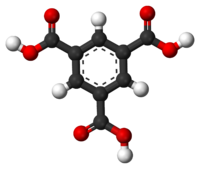This is an old revision of this page, as edited by ZéroBot (talk | contribs) at 22:54, 30 October 2011 (r2.7.1) (Robot: Adding pl:Kwas 1,3,5-benzenotrikarboksylowy). The present address (URL) is a permanent link to this revision, which may differ significantly from the current revision.
Revision as of 22:54, 30 October 2011 by ZéroBot (talk | contribs) (r2.7.1) (Robot: Adding pl:Kwas 1,3,5-benzenotrikarboksylowy)(diff) ← Previous revision | Latest revision (diff) | Newer revision → (diff)
| |

| |
| Names | |
|---|---|
| IUPAC name benzene-1,3,5-tricarboxylic acid | |
| Identifiers | |
| CAS Number | |
| 3D model (JSmol) | |
| ChEBI | |
| ChEMBL | |
| ChemSpider | |
| DrugBank | |
| ECHA InfoCard | 100.008.253 |
| EC Number |
|
| PubChem CID | |
| CompTox Dashboard (EPA) | |
InChI
| |
SMILES
| |
| Properties | |
| Chemical formula | C9H6O6 |
| Molar mass | 210.14034 |
| Acidity (pKa) | 3.12, 3.89, 4.70 |
| Except where otherwise noted, data are given for materials in their standard state (at 25 °C , 100 kPa).
| |
Trimesic acid, formally known as benzene-1,3,5-tricarboxylic acid, is a benzene derivative with three carboxylic acid groups.
Trimesic acid is a planar molecule (and is one of only four benzenecarboxylic acids with that property).
Trimesic acid can be combined with para-hydroxypyridine to make a water-based gel, stable up to 95 °C.
Trimesic acid crystallizes from water in a hydrogen-bonded hydrated network with wide unidimensional empty channels.
See also
References
- Brown, H.C., et al., in Baude, E.A. and Nachod, F.C., Determination of Organic Structures by Physical Methods, Academic Press, New York, 1955.
- ZORAN MARKOVIĆ, DALIBOR BADJUK and IVAN GUTMAN (2004), Geometry and conformations of benzenecarboxylic acids. J. Serb. Chem. Soc. volume 69 issue 11, pages 877–882 (paper JSCS 3214), UDC 547.584/.585:539.193:54.02
- Li Ming Tang and Yu Jiang Wang (2009), Highly stable supramolecular hydrogels formed from 1,3,5-benzenetricarboxylic acid and hydroxyl pyridines. Chinese Chemical Letters volume 20, issue 10, pp. 1259–1262. doi:10.1016/j.cclet.2009.04.030
- F.H. Herbstein (1987), Structural Parsimony and Structural Variety Among Inclusion Complexes, Top. Curr. Chem., volume 140, p. 107
This article about an organic compound is a stub. You can help Misplaced Pages by expanding it. |